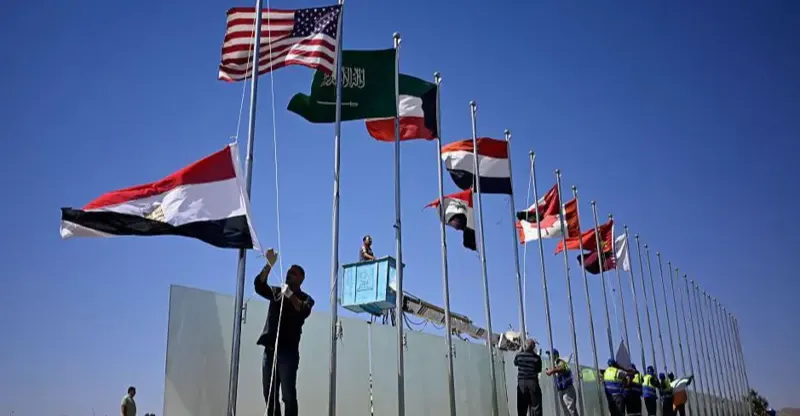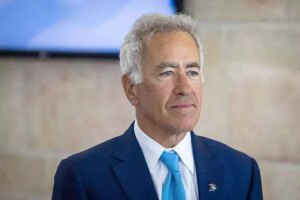
Shafaq News – Cairo
Egypt convened an expanded summit in Sharm
El-Sheikh on Monday to convert the first phase of the Gaza understandings into
a broader political track.
Framed by Egyptian stewardship and US
re-engagement under President Donald Trump, the meeting tested whether a
high-level coalition could move beyond speeches toward enforceable steps to
halt the war and unlock reconstruction. The stakes are immediate for Gaza’s
devastated population and wider for a region where any ceasefire will collapse
if neighboring fronts reignite.
The guest list underscored the ambition.
President Abdel Fattah al-Sisi and President Trump co-chaired as Egypt received
a dense lineup of leaders and senior officials: Turkish President; Qatar’s
Emir; Jordan’s King; Bahrain’s King; Palestinian Authority President; French
President; German Chancellor; Italian Prime Minister; Saudi Foreign Minister;
British Prime Minister; Canadian Prime Minister; former UK Prime Minister Tony
Blair; UN Secretary-General Antonio Guterres; and Arab League Secretary-General
Ahmed Aboul Gheit.
Delegations also arrived from Iraq,
Indonesia, Pakistan, Greece, Paraguay, and the Netherlands, alongside
international institutional representation, including FIFA President Gianni
Infantino. Cairo presented the purpose in clear terms: end the war in the Gaza
Strip, enhance regional peace efforts, and inaugurate a new phase of security
and stability.
Behind the optics lies a sequence that began
with Trump’s 20-point plan unveiled on September 29—ceasefire provisions,
detainee releases, and Hamas disarmament—followed by US–Egyptian–Qatari
mediation between Hamas and Israel. The first-phase implementation, announced
in Sharm El-Sheikh on October 9 and activated on Friday, created the political
space for today’s broader push. Whether this becomes a pivot depends on two
hard variables: legal enforceability and regional containment.
Within Egyptian security circles, retired
Lieutenant General Samir Farag rejects the notion that the summit is mere
theater. He locates its weight in Washington’s direct management of the file
and in a rare alignment between Arab capitals and key European partners.
For Farag, the crucial test is the transition
from a ceasefire to verified steps that include the disarmament of Hamas and a
full Israeli withdrawal from Gaza—a sequence he deems grueling but not
unattainable if US pressure is sustained and Arab–European guarantees are
codified. In his reading, Sharm El-Sheikh is where choreography meets coercive
diplomacy; one without the other will fail.
From Ramallah, International Relations
Scholar Ashraf Akka reads the same moment as a necessary course correction
rather than a grand bargain. He argues that Trump’s plan—whatever its
branding—now operates inside a regional, not unilateral, logic, with Cairo
coordinating more widely than at any time since October 2023.
The point, as he frames it, is simple: “even
adversaries have converged on the limits of war, and publics across the region
are out of patience with speeches unmoored from deliverables.”
In Akka’s view, the formula must be
comprehensive to hold: de-escalation in Gaza cannot survive if the northern
front ignites or if strikes continue in Syria and beyond. He places particular
emphasis on cross-theater guardrails, including channels that reportedly touch
Tehran—an innovation he considers indispensable for durability.
Jordanian researcher Kamal Zaghloul
interprets the understandings as the opening stage of a regional de-escalation,
not a blueprint for an immediate Palestinian state. He anticipates a pivot
toward investment and reconstruction, arguing that stabilization only becomes
self-sustaining when energy, water, housing, and employment indicators start to
improve—and when financial flows are fenced by transparency and oversight
stringent enough to reassure donors and investors alike. In short: “security
first, but economics fast.”
Set against these pragmatic readings,
Palestinian rights advocate Salah Abdel-Ati, who heads the International
Commission to Support Palestinian Rights (HASHD), draws the sharpest red lines.
For him, legal enforceability is the fulcrum. “Without binding decisions to
stop the killing, lift the blockade, and launch reconstruction, Sharm El-Sheikh
risks becoming another diplomatic ceremony with no strategic effect.”
His metric is not atmospherics but
obligations and mechanisms: third-party monitoring, penalties for
non-compliance, and a calendar that cannot be gamed.
These strands converge around three
interlocked challenges that will decide the summit’s legacy. The first is
enforcement and sequencing—graduating from truce and detainee exchanges to
verifiable demilitarization and withdrawal under a synchronized, enforceable
calendar.
The second is Gaza’s governance and security
vacuum—crafting an interim arrangement that can maintain order while commanding
Palestinian legitimacy, whether via an Arab-led multinational presence, an
empowered Palestinian Authority under international supervision, or a hybrid
that avoids the pitfalls of external imposition.
The third is regional firebreaks—ensuring
that a Gaza-only formula is insulated from escalation along the Lebanon–Israel
frontier or spillover into Syria or Iran; here, Egypt’s widened coordination
could prove decisive in establishing cross-theater deterrence.
If today’s summit anchors those
pillars—monitoring architecture, a staged lifting of the siege, transparent
reconstruction finance, and an agreed schedule for withdrawal steps—confidence
could scale quickly. That would open the door to a donor framework capable of
delivering early wins in power generation, water access, housing, and jobs,
turning a paper roadmap into visible gains.
In that scenario, Zaghloul’s economic pivot
becomes plausible; the political center in multiple capitals gains breathing
room; and Farag’s argument about the utility of sustained US leverage is tested
positively on the ground.
If, however, the meeting closes with eloquent
communiqués unbacked by law or timelines, Abdel-Ati’s critique will define the
verdict: corridors may widen briefly, but the cycle of devastation risks
returning with a familiar regularity—truce, flare-up, truce—while the political
horizon narrows. That outcome would strengthen maximalists across the region
and complicate even the practical cooperation that Cairo and Amman are trying
to preserve.
For now, Sharm El-Sheikh offers a narrow
opening. Whether it becomes a pivot rather than a pause will be decided not by
the breadth of the photo but by the depth of what is signed, verified, and
implemented in the days that follow.
Written and edited by Shafaq News staff.





